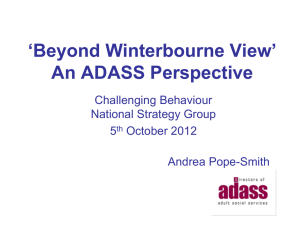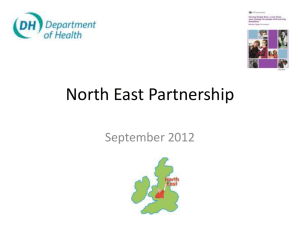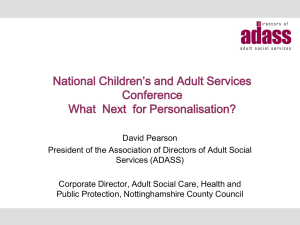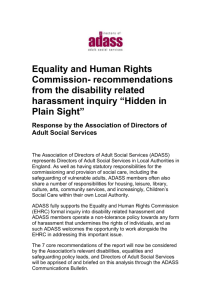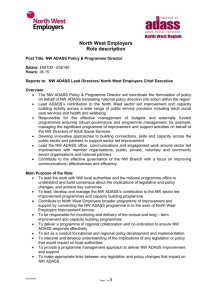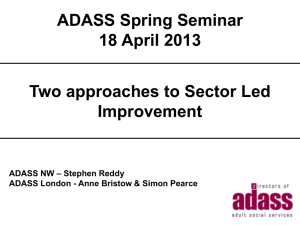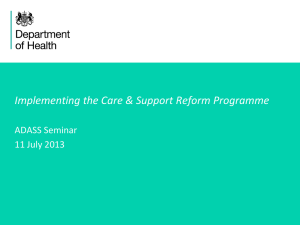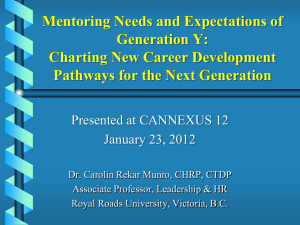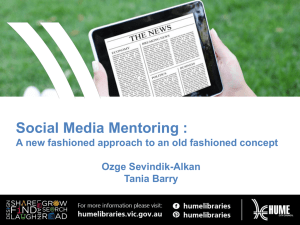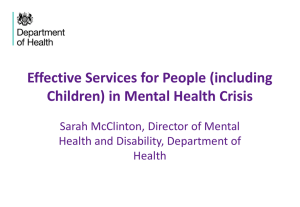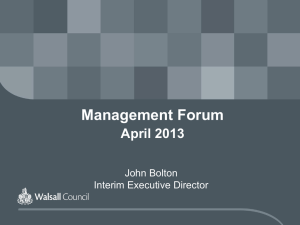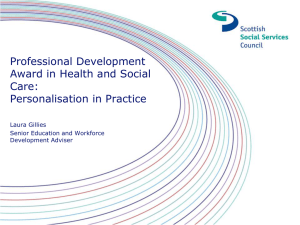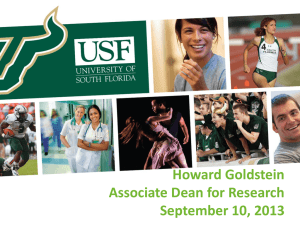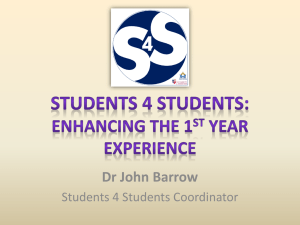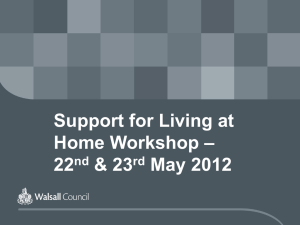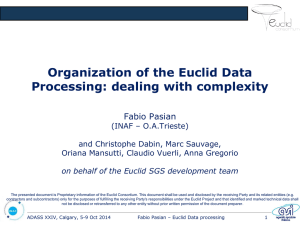Social Capital and Community Capacity Building
advertisement
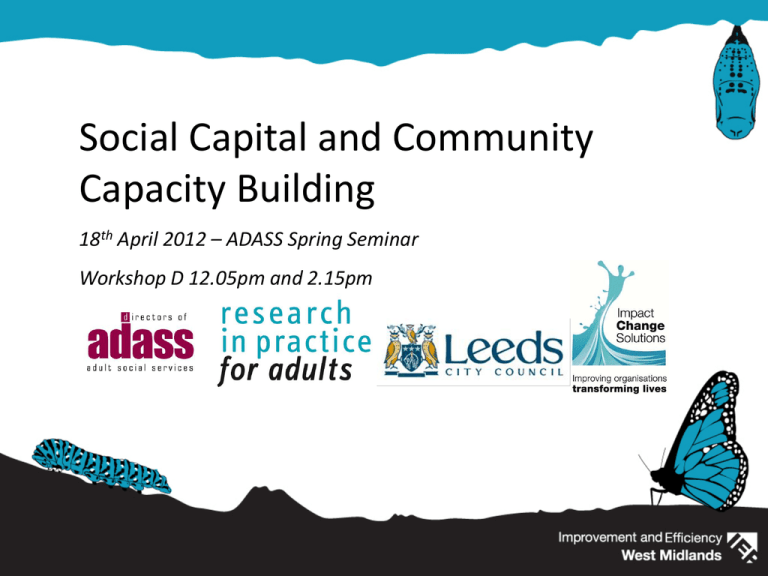
Social Capital and Community Capacity Building 18th April 2012 – ADASS Spring Seminar Workshop D 12.05pm and 2.15pm Introduction Andrea Pope Smith- ADASS WM Branch Chair • Objectives for the day - Show practical examples of how community capacity is developing in the light of both Think Local Act Personal and the Localism Act Enable a short group discussion about barriers and successes to stimulating community capacity • Housekeeping - Mobiles to silent please No scheduled fire alarm The Role of Social Capital in Supporting Transformation George Julian- Director RIPFA ‘Care must again be about reinforcing personal and community resilience, reciprocity and responsibility, to prevent and postpone dependency and promote greater independence and choice’ (DH, 2010) Clear evidence for two types of outcomes • Effectiveness: improvement of wellbeing • Cost-effectiveness: from given resources, achieve better outcomes for service users, carers and those at risk of needing support Building community capacity is effective and cost-effective • Individual level (e.g. trust, independence, participation, reduced isolation) • Community/societal level (e.g. neighbourhood improvements, inclusion, finding employment) Evidence: Boyle 2005, Bruce et al 2011, Eversole 2010, Fisher et al 2011, McCabe 2010, Knapp et al 2012, Milton et al 2011, Sherrieb et al 2010 Costs and economic consequences of time banks per person per year (Knapp et al, 2012) Calculation Cost of intervention Mean value See table 1 £607 (£312-£902) Economic consequences Employment 0.045*£11,132 £501 Reduced benefit claims 0.045*£80*52 0.09 (midpoint DCLG citizenship survey 0.060.12) *£5.8*12.5hrs/months*12 29hrs*£17.5 £187 £78 Volunteering Value of services received Net benefit (government) Quality of life improvements Net economic value £508 £667 (38/365)*(1-0.69)*£20,000 £645 £1,312 Costs and economic consequences of befriending per person per year (Knapp et al, 2012) Cost of intervention Economic consequences Reduction in health services costs (and home helps) Calculation Mean value (range) Lowest value: 12hrs*£4.8=£58 Highest value: 12hrs*£10=£120 -£90 (£58-£120) 2.62*£14.5 +£38 Net (cashable) benefit -£52 Quality of life improvements (reduction in depressive symptoms 3-12 months) Lowest value: (38/365days)*(1-0.69)* £20,000* 0.25=£162 Highest value: (38/365days)*(10.69)*£20,000=£645 +£404 (£162-645) Net economic value +£424 Return on investment 0.58-4.71 Case Study 1: Encouraging Community Enterprise, Innovation & Active Citizenship Mick Ward- Head of Commissioning Leeds City Council • Enterprise; Volunteering, Corporate Social Responsibility and Third Sector models • Ideas that Change Lives • NNS ‘Combining Personalisation with Community Engagement’ project Better Lives Through….Enterprise • Volunteering – Social Capital – Recognition and Reward – It’s Good For You! • Corporate Social Responsibility – Long Term Relationships – Shared Vision and Values – Investment, Not a Gift Better Lives Through….. Enterprise • Encouraging a Range of Social Enterprise Models – Co-Operatives – User Led Organisations – Community Interest Companies – Micro Enterprises Better Lives Through….Enterprise • Ideas that Change Lives - Investment Fund and Business Support for Social Enterprises – CASA – Get Cooking – Experience Community – Careforce – Beat It Music Better Lives Through….Enterprise • Combining Personalisation with Community Engagement – Further Develop the Neighbourhood Networks in Leeds – Joint Assessment in the Community – A ‘New Offer’ to meet needs identified; local universal services, expanded provision by the NN’s, brokering care services – Savings to be shared between ASC and the community – Resources and control move to the community Case Study 2: Encouraging Providers to Change Paul Johnston- Impact Change Solutions & Matt Bowsher ADASS West Midlands Shaping the Market = Mobilising Community Capital Robust Intelligence Productive Relationships Accessible Providers Provider Stimulus Active Maintenance Strategy into Practice • New relationship with Providers: Warwickshire’s Market Facilitation Team • Support for Peers: Staffordshire’s Mentoring Service • Improving Quality within Nursing & Residential Care: Walsall’s Quality Assurance Team A New Relationship Warwickshire’s Market Facilitation Team • New function within Strategic Commissioning • Focus on ‘developing the market’ • Proactive engagement with providers • Gathering & sharing intelligence & priorities • Collaborative working in a competitive environment • Addressing shared challenges and co-designing solutions The Power of Peers Staffordshire’s Mentoring Service • 2010 pilot leading to contract from April 2011 (Age UK South Staffs) • 40 hours per month mentoring support for up to 12 CVS organisations at any one time • Mentoring aims to help organisations to: – – – – develop their business management skills; develop their capacity to deliver services; develop their services to support the Council’s Personalisation Agenda; assist to create an environment for a thriving third sector. • £10k pilot costs, £30k pa contract for 2 years • Improved viability, access to external funding, diversification Incentivising Quality: Walsall • • • • • • Joint Quality Board Proactive resident engagement LA Quality Assurance Team Building relationships with sector Range of financial incentives (CHQIIS) Quality Requirements and Incentives reflect improvement priorities • Changes to contract monitoring arrangements Q+ A Session Questions for the panel & please highlight successes and challenges in building community capital locally Additional Resources • http://www.ripfa.co.uk/user-led-organisations (RIPFA on building social capital) • http://www.marketshaping.co.uk/mobilising-community-capital (Impact Change Solutions – strategy and tools to support market shaping) • http://wwwjipwestmidlands.blogspot.com (ADASS West Midlands ebulletin) Additional Queries to Matt Bowsher (M) 07500 944 766 (E) mbowsher@westmidlandsiep.gov.uk Closing Remarks Andrea Pope Smith- ADASS WM Branch Chair • Key points arising • Slides and supporting resources available via ADASS • Thanks for participating
